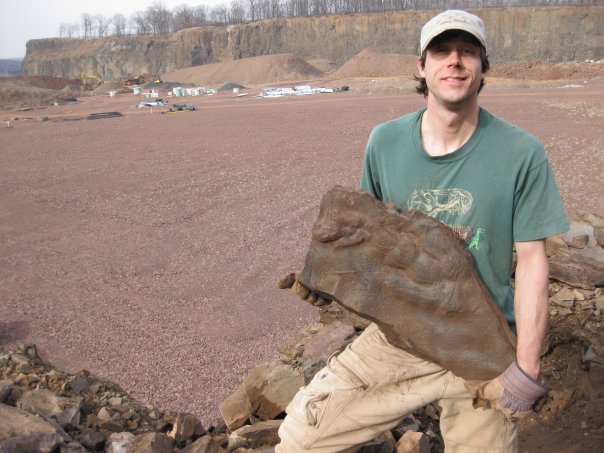It was a week before the Academy of Natural Sciences biggest paleo weekend of the year called Paleopalooza. The third annual year to host the event after two previous years of overwhelming success. Crowds were expected to fill the museum to capacity and break previous attendance records for the event. When I was approached by Larry Decina of the Delaware Valley Paleontological Society a week before the big event to have the New Jersey Track and Trace Museum set up an exhibit on dinosaur tracks and trace fossils of New Jersey, I could not turn down this opportunity. With only a week to prepare, I had to dig into the collections of the NJTNTM and find unique specimens that not only would be eye shocking to the visitors but also provide an educational lesson in the process. Size was also an issue as many dinosaur tracks are typically preserved on large slabs of rock that are not easily transportable for a weekend event. When people think of dinosaurs they think of the big beasts like Tyrannosauarus, Titanosaurus, Tricerotops, etc all from the Cretaceous period. New Jersey’s dinosaur tracks however are located in a much older period of time from the Late Triassic to the Early Jurassic period. Dinosaurs have not reached gigantic size during this time and were much smaller in scale. Tracks may have been a centimeter up to a foot and a half in length. Dinosaurs such as Coelophysis, Dilophosaurus, and ornithischians were the main suspected track makers roaming the lowland mudflats of New Jersey leaving tracks such as the Grallator, Anomoepus, and the very large Eubrontes. These periods were also a time of reptiles and many of the track makers were small reptiles such as Stegomus, phytosaurs, and crocodile type creatures. Tracks such as Rhynchosauroides, Batrachopus, Brachychirotherium, and Apatopus were all familiar track names ranging from the Late Triassic and Early Jurassic for these reptiles.
So the selections were made from the collection to take to ANSP and the collection for display strategically prepared. The trip down to Philadelphia was a two hour drive down from Rutherford, NJ, (New Jersey’s home of the NJTNTM). I was meeting up early with fellow friend and member of the NJTNTM, Henry Vila and his son to help with the setup of the display. The anticipation of setting up the exhibit and receiving feedback on the trace fossils from New Jersey was running through my mind. Afterall they were being displayed amongst other extraordinary collections such as Fossils of the Chesepeake Bay Region by Charles Barr, and Late Cretaceous Mollusks from the Pierre Seaway in Montana by Paul Torna. Having these extraordinary collections displayed in America’s first Insitute of Paleontology among other historical dinosaurs such as Hadrosaurus folki, Dryptosaurus aquilunguis, and the collections in the dinosaur hall was quite an honor to continue in the tradition of this Academy’s paleontological history of amazing fossils.
Crowds came from near and far and began to pour into the museum on day one. Lines stretched around the corner of the museum to engage in the events at Paleopalooza. Dinosaur Train entertainers, distinguished paleontologists, and volunteers roamed the halls of the Academy welcoming every fossil enthusiast from kids and families to the science professional. One of their stops of the day would be the NJTNTM’s Dinosaur Tracks and Trace Fossils of New Jersey Exhibit. Here they had a rare opportunity to see a diverse collection of dinosaur tracks and other trace fossils from New Jersey. A collection rarely seen by the public as most museums may have on display one or two dinosaur tracks but here they were able to view about 30 trace fossils. Everyone that I had spoke to throughout the weekend event were astonished that these fossils on display actually came from New Jersey. Who knew that New Jersey could have such a diverse assemblage of dinosaur and reptile tracks. The interest in the start of the New Jersey Track and Trace Museum became even more evident as a project that needs to be continued as I gained valuable information and support from the scientific community, the Academy of Natural Sciences, and the general public. Most folks that I talked to said they would like to see more of these trace fossils and to have a museum dedicated specifically for these fossils would be an asset to New Jersey’s paleontology history. From this event the NJTNTM has been asked to display the trace fossil collection at two more events this spring. One at the Delaware Valley Paleontological Society’s annual Fossil Fair April 2nd and 3rd, 2011 and at the New Jersey State Museum in Trenton, NJ for their annual Fossil Day in mid April, 2011. So be sure to check out the fossils again if you missed them. Be sure to leave your comments and feedback if you did see the trace fossils at the Academy of Natural Sciences Paleopalooza.
Thanks.
John McCauley
